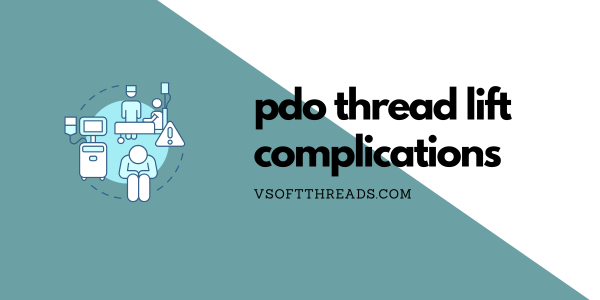
PDO thread lifts are safe and minimally-invasive procedures that mimic the results of a traditional surgical facelift. They help to rejuvenate your skin while addressing common problem areas such as under the neck, around the lips, in the cheeks and under the eyes.
The procedure is considered very safe and generally has minimal complications. Since there is no surgery required, the downtime and recovery time associated with PDO threads are much less than that of a traditional facelift, too.
Most PDO threads procedures are completed within one hour, and patients can resume much of their daily activities as soon as they leave the office. Since the threads are made from a synthetic polymer (polydioxanone) that is completely biodegradable and biocompatible, the body will use natural processes to break them down over time.
This is also the reason why there are typically much fewer complications with a PDO thread lift procedure than there are with a traditional facelift. That being said, there are some potential complications that you should be aware of.
We discuss some of these potential PDO thread lift complications below.
Because PDO Threads are made from a synthetic polymer (polydioxanone) that is completely biodegradable and biocompatible, the body will use natural processes to break them down over time. This is also the reason why there are typically much fewer complications with a PDO thread lift procedure than there are with a traditional facelift. That being said, there are some potential complications that you should be aware of.
Table of Contents
Add a header to begin generating the table of contents
 Medically reviewed by: Elizabeth Williams RN
Medically reviewed by: Elizabeth Williams RN
Updated: 10/16/2024
Bruising and/or Swelling
Most people who get a PDO thread lift experience minor bruising and/or swelling. This is a natural reaction that your body will have to a foreign object being inserted into it.
In most cases, this bruising and/or swelling will resolve itself within about a week. You can treat it in the meantime with ice and some over-the-counter medications
Your practitioner should advise you, though, to avoid taking any medications with aspirin or any NSAIDs for at least a few weeks after your procedure, as it could interfere with healing and, as a result, the quality of your procedure.
Thread Extrusion
In some instances, it’s possible that part of the PDO thread could poke out of your skin, which is called thread extrusion. This often happens if the thread isn’t buried sufficiently in your skin after your practitioner has cut it.
If this happens, movements may cause thread extrusion over time. This is something that can be fixed with another visit to your practitioner.
Learn more about the risk of thread extrusion and PDO Threads
Nerve Damage
Nerve damage is rare with PDO thread lift procedures, but it is possible. The reason why it’s rare is that the threads are normally inserted into the subcutaneous skin layer, which means they shouldn’t ever come into contact with a nerve.
If the PDO thread is inserted deeper or if the procedure is done in an area that is considered high risk, then you could experience nerve damage. This would result in you feeling muscle weakness and/or numbness.
Learn more about the risk of nerve damage and PDO Threads
Asymmetry
If the PDO threads aren’t placed properly or if your skin is pulled unevenly, it could give you asymmetrical results. This is obviously something that you wouldn’t want to see.
If this happens, your provider should be able to correct it with an adjustment, a different method or a different type of thread, depending on your situation.
Infection
Any time that a puncture is made in your skin, there’s a possibility for an infection. This is true of everything from PDO thread lift procedures to a simple vaccine shot.
With PDO thread lifts, infections are considered rare. As long as they are done properly, in a sterile setting and by an experienced practitioner, you likely will not run into this potential complication.
If you do, you will most likely experience swelling, redness, pain and/or pus happening where the PDO threads were inserted.
Learn more about the risk of infection with PDO Threads
Vascular Occlusion
Again, whenever something is being inserted into your body, there’s a chance that vascular occlusion, or a blood vessel blockage, could occur. Just like nerve damage, though, vascular occlusion is rare in PDO thread lift procedures.
The reason for that is the same as with nerve damage — the PDO threads shouldn’t be inserted deep enough into your skin that they would come into contact with an artery or vein.
If they are inserted too deep, it is possible that this could occur. It is possible to remove the blockage if it does happen, which would help to improve blood flow in your body.
Learn more about PDO Threads and the risk of vascular occlusion
Visit a Trustworthy Provider Who Uses V Soft Lift PDO Threads
PDO thread lift procedures are considered very safe in most cases. While there are some potential complications, many of them are rare. Those that are more common, such as bruising and/or swelling, are minor and typically resolve themselves within a week.
To ensure that you have the fewest complications possible, it’s important to visit a provider that is trustworthy, licensed and experienced with PDO threads. Their office should be a clean environment to reduce the chances of infection and complications.
In addition, you should look for a provider who uses PDO threads created by V Soft Lift. We have created many different types of PDO threads so your provider can choose the ones that are best fit for your procedure and skin type, which ensures the best results possible.
For more information, contact us today.
